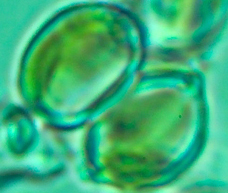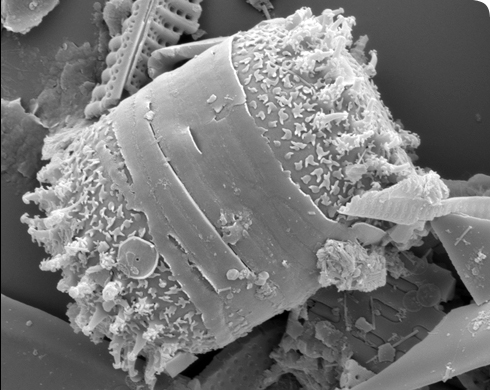Clipeoparvus anatolicus
Clipeoparvus anatolicus is an unusual small, centric diatom that was found in a crater-lake (Nar Gölü) in the continental semi-arid region of Cappadocia, Central Turkey.
Clipeoparvus anatolicus is a newly discovered species, belonging to a newly defined genus, recently described by Museum Scientist, Dr Eileen Cox and Dr Jessie Woodbridge from the University of Plymouth.
Clipeoparvus anatolicus is present in large numbers in the lake, living in the plankton and also found associated with submerged plants, rocks and gravel sediments. The lake is silica-rich, with a good nutrient supply and neutral pH.
Analysis of the modern samples and of thin sections from sediment cores show that Clipeoparvus anatolicus is an important component of the diatom flora at Nar Gölü and has fluctuated significantly in abundance throughout the last 1720 years.
Environmental change indicator

Live Clipeoparvus anatolicus under a light microscope.
Diatoms are important indicators of past environments and have been utilised in various palaeoecological studies in Turkey. Such research has strengthened our knowledge of palaeoclimatic variability in the Eastern Mediterranean region and highlighted the effectiveness of diatoms as proxy indicators of environmental change.
The description of this new diatom contributes to our knowledge of diatom diversity, while the physico-chemical data on its locality will allow future work to utilise this taxon as an indicator of environmental change.
-

Taxonomy
Clipeoparvus anatolicus are circular, domed and strongly biconvex in girdle view without a distinct girdle region. They have two yellow-brown chloroplasts that lie closely associated with the inner surface of the valves. Discover more about the structure of Clipeoparvus anatolicus.
-

Distribution and habitat
Clipeoparvus anatolicus is found in a small, extant, volcanic crater-lake Nar Gölü in the inland area of Cappadocia, located in Anatolia, Central Turkey. Lake diatoms were studied from collections of living material and fossilised specimens preserved in sediments spanning the late Holocene. Learn more about the habitat of the diatom.
-

Palaeoecology
Sediments accumulate in lakes over time, the accumulated layers containing the remains of diatoms that lived in the lake, forming a chronological record of events in the lake. The assemblage of different diatoms present in each layer of the core can tell scientists what the environment was like at particular times in history. Discover what Clipeoparvus anatolicus can reveal about the environment.
About the author
Toolbox
Naming of genus and species
The genus (Clipeoparvus) and species (anatolicus) have been named according to frustule characteristics and in relation to the region in which the diatom was identified. ‘Clipeo’ relates to the round/shield-like shape of the frustule and ‘parvus’ refers to the small size of the diatom. The species name relates to the Anatolia region of Turkey.

